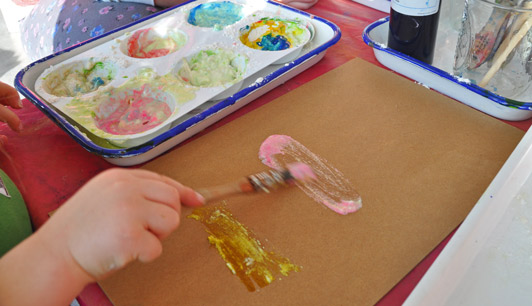There are always a variety of activities available for toddlers in the Art Studio. We have a light table, activity board, magnet board, manipulative shelf, and dedicated toddler drawing table, so young explorers can stay busy in the studio without ever sitting to produce an "artwork" to take home. Through our Every Day Art Program, available whenever the museum is open, materials are available to all museum guests, including toddlers, to explore however they wish.
Materials Play, however, is a space and time for toddlers and their parent or caregiver to have fun with materials and explorations selected and arranged especially for their interest and body size. Sometimes messy, always open-ended and experimental in nature, the four week Materials Play series happen about once a season. Usually anywhere from two to ten children and their caregivers drop-in to during that sweet spot of time between Museum opening at 10:00 a.m. and story time in the Reading Library at 10:30.

I kicked off the latest Materials Play series with an exploration that was as much science experiment as it was art-making. In the past, I’ve offered flour paint made by pre-mixing a recipe of flour, salt, water, and coloring (either food coloring or liquid watercolors) in putting small batches in condiment squeeze bottles. It was fun to squeeze the bottles, but some small hands had a hard time queezing the bottles. And when I reflected on the experiences, they didn’t feel truly toddler-centered. Half the fun and learning (measuring, pouring, and stirring) had already been done before my young explorers even arrived.
So this time, in the center of the table I put a bowl of wheat flour with measuring spoons and a container of table salt. At four individual work stations, I placed a muffin-pan style paint palette on slightly larger tray to catch some of the spill-over. Brushes, jars of water, and liquid watercolors I kept nearby.
When my young friends arrived I invited each to put some flour, a big pinch of salt, and a little water into each of their muffin tins. They poured the water from small jars that I refilled as needed. Purposefully leaving the quantities vague and imprecise in my invitation I thought would frame the exploration as an experiment rather than a recipe.

Next, I or the child’s adult added a few drops of liquid watercolor of their choosing to each pan in which they put flour, salt and water. Next time I think I’ll have colored water and pipettes available in baby food jars at a separate table to let them add the color by themselves.
Then, when each child was ready, I handed them three brushes and observed as they stirred and mixed. For a few it was all about the texture: mixing, stirring, and adding more water or flour to change the consistency. A few others intently tweaked their colors, missing from pan to pan to see how the colors changed. At least five of the ten kids that participated tried brushing their paint on a piece of chipboard or a scrap of white mat board.
That I didn’t have all ten kids at once made it possible to do this at our one super-low table. At most there were five kids working at a time. If I were to do this experiment with more kids starting simultaneously, the setup would have to be adjusted. I might like to have the scooping and pouring happening at a separate table from the mixing and painting.
If you're concerned about your young artist tasting the paint, you could make your own food dyes, or order a set online. If wheat allergies are a concern, try rice flour.
Have you and your kids tried any paint mixing experiments? What ingredients did they enjoy testing?

